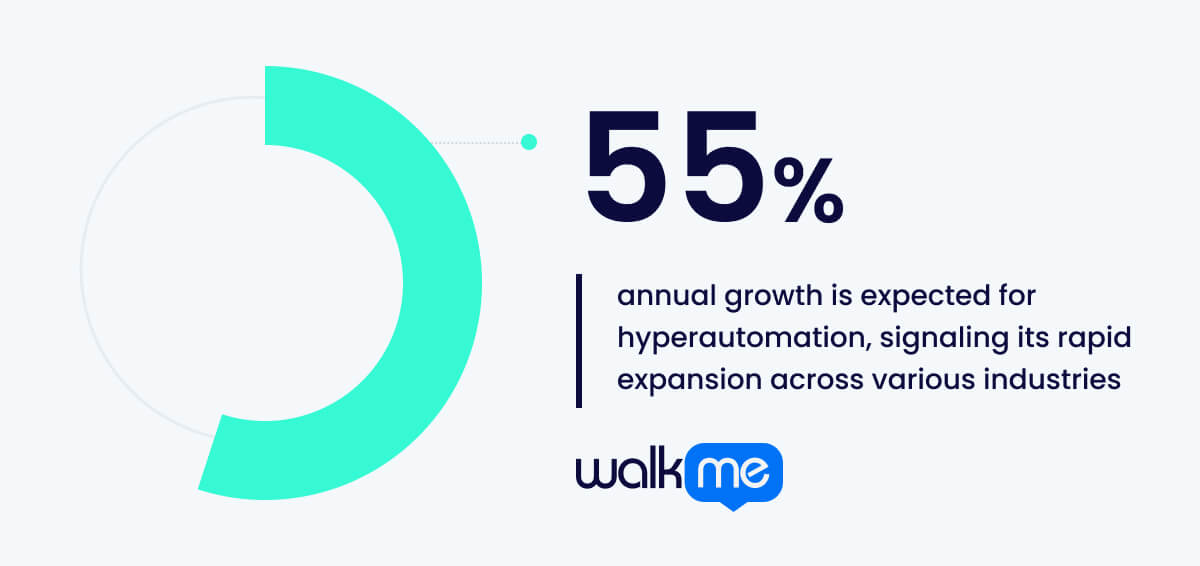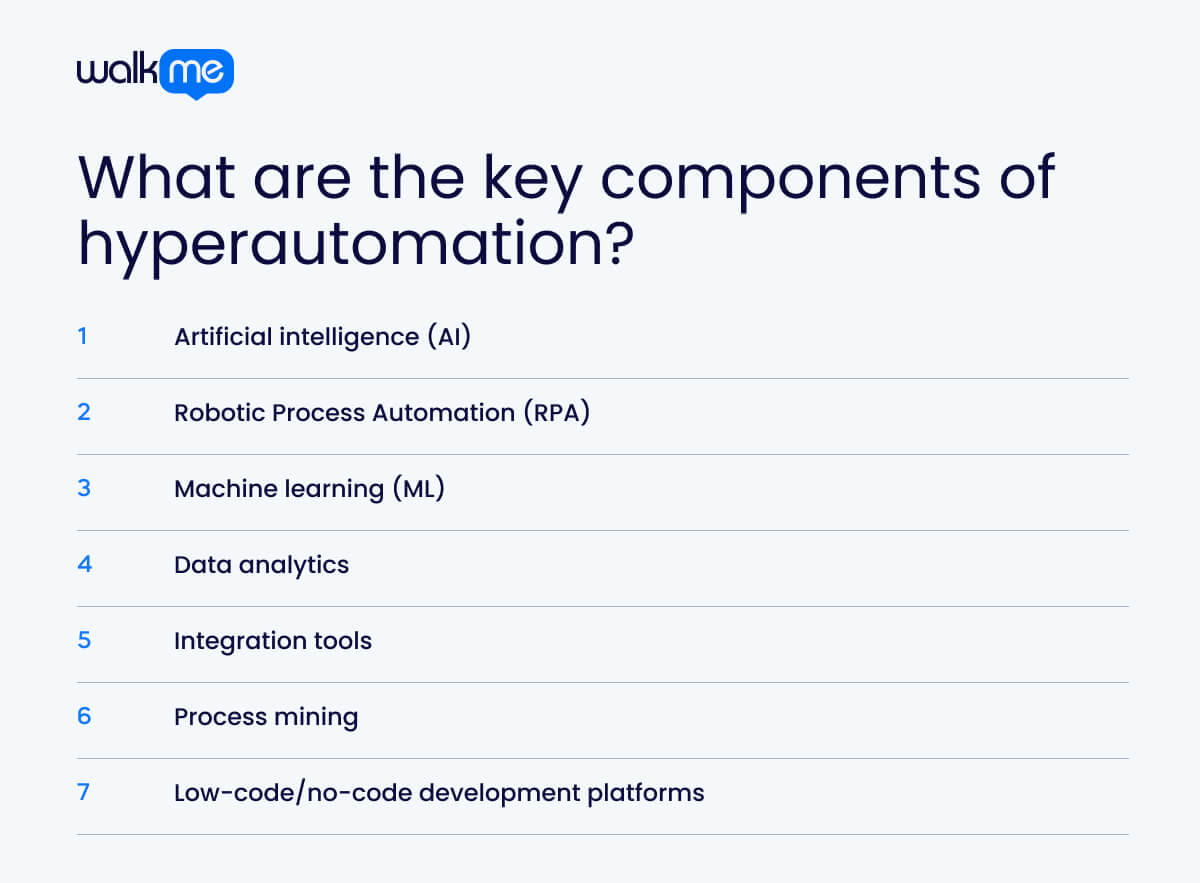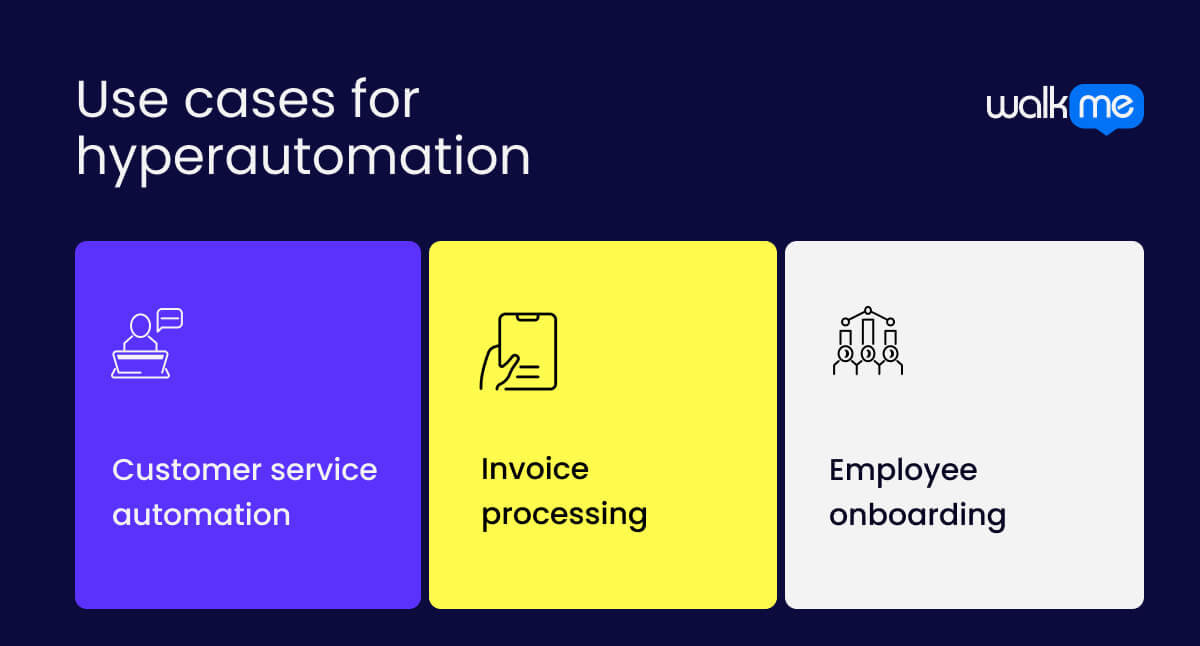Hyperautomation

Table of contents
What is hyperautomation?
Hyperautomation means using technology to do tasks by itself. It uses smart tools like artificial intelligence (AI), machine learning, robotic process automation (RPA), and data analysis, which help make work easier and faster.
With hyperautomation, businesses find jobs that machines can do instead of people. They set up these tools to do those jobs, which helps everything run smoothly. As time goes on, businesses can make these tools even better. The company can, therefore, handle more work efficiently.
Many types of businesses can use hyperautomation. For example, banks can use it to pay bills and make reports. Hospitals can use it to keep track of patients and set up appointments. With hyperautomation, companies can work smarter and better help their customers.
According to Gartner, to speed up hyperautomation, companies should create an integrated system that combines tools for Digital Operations with technologies. These include artificial intelligence (AI), machine learning (ML), natural language processing (NLP), optical character recognition (OCR), and conversational chatbots.
Hyperautomation is expected to grow rapidly, with an annual growth rate of over 55% across various industries.

What are the key components of hyperautomation?

Knowing the key components of hyperautomation is essential for understanding how it changes businesses’ work. Together, these components help businesses run smoothly and adjust to new situations. Let’s look at the important parts that work together to make hyperautomation work well.
Artificial intelligence (AI)
Artificial intelligence (AI) helps computers think and learn like people. With AI, computers can look at a lot of information, see patterns, and make decisions by themselves. For example, AI can help answer customer questions, making work easier and faster for everyone in the business.
Robotic Process Automation (RPA)
Robotic Process Automation (RPA) uses special robots to perform tasks that people usually have to do repeatedly. These robots can enter information, make reports, and help with many simple jobs. By using RPA, businesses can save time and make fewer mistakes because the robots do everything quickly and correctly.
Machine learning (ML)
Machine learning is a special part of AI that helps computers learn from their experiences. The more information the computer gets, the better it gets at doing its job. In hyperautomation, machine learning helps businesses find better ways to do things and solve problems. It makes everything work smoother over time.
Data analytics
Data analytics helps businesses see how well things are going and what needs fixing. With data analytics in hyperautomation, companies can better understand their work and make smarter choices to improve.
Integration tools
Integration tools help different computer programs talk to each other. They’re like bridges that connect two sides of a river. These tools ensure that all information from different places can be shared easily. This process helps everyone in the business have the right information at the right time.
Process mining
Process mining examines work to identify areas where it slows down or gets stuck. It helps businesses identify areas where work can be performed faster. By identifying slow areas, companies can decide which jobs to let robots do, making everything quicker and easier.
Low-code/no-code development platforms
These platforms let people create apps and tools without needing to know how to write computer code. Therefore, even people who aren’t technology experts can create things that help their work. This helps everyone in the business find ways to automate tasks and improve their work.
Hyperautomation vs. automation
Hyperautomation and automation both help make work easier and faster, but they do it in different ways.
- Automation uses machines or software to do one job without much help from people.
- Hyperautomation uses many smart tools to make whole processes better and lets different systems work together smoothly.
Let’s learn more about how these two ideas are different.
| Hyperautomation | Automation | |
| Definition | Like automation but even better. It uses smart tools, like robots that can learn and think, to do many jobs together. As a result, it can handle harder tasks, not just simple ones. | When machines or computers do jobs by themselves without needing people to help. For example, a machine might sort products or send emails on its own. |
| Focus | Tries to make whole groups of jobs work better together. It helps different machines and computers connect so they can all help each other. | All about making one job easier and faster. It looks for things that machines can do instead of people, like packing boxes. |
| Techniques | Uses smart tools, like computers that can think and learn, to do more complicated work. For example, understanding what customers want and helping many parts of a business work together. | Uses simple tools, like computer programs or robots, to do tasks. For example, a robot might pick up items on a shelf. |
| Goals | Wants to make everything work better in a business. It aims to help people do their work more easily and get things done correctly. | Wants to save time and make one job quicker. For example, it can help sort mail faster. |
| Examples of use | Used in places like banks, where it helps with many tasks at once, like helping people open accounts and keep track of their money. In hospitals, it can help find patients, set up doctor visits, and keep everything organized using smart tools. | Can be found in simple things, like a computer that automatically sends birthday messages or a robot that picks up trash. |
Use cases for hyperautomation

Hyperautomation makes things faster and easier, such as helping customers with questions using smart chatbots or better-managing bills.
Let’s look at three examples to see how hyperautomation works in real life.
Customer service automation
Hyperautomation improves customer service. Smart chatbots answer questions from customers, such as where their orders are or how to return things.
These chatbots can help many customers at once, which makes getting help much faster. If a chatbot can’t solve a problem, it can send the question to a real person who can.
As a result, customers get answers quickly, and the support team can focus on tougher questions, which ultimately makes everyone happier.
Invoice processing
Hyperautomation makes handling invoices much easier for businesses. The system can automatically gather invoices from places like emails and websites and use smart technology to check the information.
It enters all the needed details into the accounting system and finds any mistakes that need fixing.
Businesses get paid faster, and there are fewer errors, which saves time and money. With less manual work, employees can focus on more important things, leading to a better work experience.
Employee onboarding
Hyperautomation helps welcome new employees to a company. When someone new starts, the system can automatically send welcome emails, set up training schedules, and create accounts for different tools.
It gathers all the important information in one easy place, so managers don’t have to do everything manually.
It becomes easier for new workers to get started quickly and comfortably. As a result, they can feel more ready and excited to join their new team right away.
What are the benefits of hyperautomation?
Hyperautomation offers many great benefits for businesses. By using smart machines and technology, companies can make their work easier and faster. This leads to saving time and reducing mistakes, helping businesses grow and better serve their customers.
Let’s explore in detail all the advantages that come with using hyperautomation.
Saves time
Hyperautomation uses smart machines to do jobs quickly, so businesses can finish their work sooner. Having extra time lets workers think of new ideas or improve their work. Because of this, companies can do more each day and get even better at what they do.
Reduces mistakes
Machines that perform tasks usually make fewer mistakes than people. Hyperautomation helps ensure that everything is done right, so there are fewer errors. As a result, the work gets done correctly the first time, making everything run more smoothly. With fewer mistakes, customers are happier, and businesses look good because they do a great job.
Improves efficiency
The process helps businesses work well together, like a team. It brings different tools and workers together so everyone can help each other. When tasks are easier to handle, workers feel less worried and can do their jobs better. The work environment becomes better, and it helps everyone do more.
Boosts customer satisfaction
When businesses use hyperautomation, they can help customers much faster. For example, chatbots can answer questions any time, day or night, making customers feel cared for. Access to quick help makes customers want to come back and tell their friends about the business. Happy customers help the company grow and do well.
Helps with decision-making
Hyperautomation collects important information and gives smart ideas to businesses. By looking at real data, companies can make better choices, like when to sell something new or change what they offer. Good decisions help businesses find new ways to grow and avoid problems, making their future look bright.
Supports growth
As companies grow, hyperautomation helps them keep up with more work. It can handle many tasks without needing to hire many new people. Businesses can, therefore, grow and take on new challenges without the human workforce getting too tired. As a result, companies can keep doing well in their fields.
Increases flexibility
With hyperautomation, businesses can change their plans quickly when they need to. They can keep up with new trends and try out new ideas fast. Flexibility means companies can stay strong and meet their customers’ needs, no matter what happens.
Lowers costs
Businesses can save money in many ways with hyperautomation. By letting machines do jobs that take a long time, companies can spend less on workers for those tasks. With the money they save, businesses can make better products, improve their services, or care for their workers. Everyone is happier, and the process helps the company do well.
What are the challenges of hyperautomation?
Now, let’s discuss the challenges of hyperautomation. Even though this way of working can help businesses do things faster and better, there are some problems to face. These challenges can make it hard to set up and use hyper-automation correctly. Companies need to know about these problems so they can plan and find ways to fix them.
High initial costs
Starting hyperautomation can cost a lot of money. Businesses must pay for new tools, technology, and worker training. These expenses can add up quickly, making it hard for smaller companies to start their hyper-automation journey.
Integration issues
Making sure all the different systems and tools work together well can be challenging. Sometimes, older systems need to connect more easily with new technology. A situation like this can create problems that slow the automation process and make extra work for teams.
Change management
When businesses begin using hyperautomation, it can change how people work. Employees may feel unsure or not happy about these changes, which can lead to confusion. Companies need to help manage this change and support their workers so everyone can adjust to new ways of doing things.
Data security risks
With more automation, businesses handle a lot of data, which can create security worries. It is very important to keep important information safe from cyber threats. Companies need to invest in security measures to protect their data while using hyperautomation well.
How can DAPs help with hyperautomation?
Digital adoption platforms (DAPs) are beneficial for making hyperautomation work better in businesses. When companies use a DAP, they get tools that help them understand and use automation technology. These platforms make it easier for workers to learn new automated tasks to do their jobs faster and better.
Let’s look at how DAPs help hyperautomation in different types of businesses.
Easy onboarding
DAPs help users learn how to use hyperautomation tools quickly and easily. The platforms offer step-by-step guides and fun lessons that show how to set up and use the tools. This process makes it less confusing for workers and helps them start using hyper-automation immediately.
Real-time assistance
These platforms provide help while users are working on tasks. If someone gets stuck or has a question, they can get quick answers and support. Real-time help makes it easier to solve problems and keeps work running smoothly without significant delays.
Performance tracking
Digital adoption platforms can track users’ performance with hyperautomation tools. They gather information on how tasks are completed and what is working well. Businesses can see where to improve and make changes to use hyper-automation even better.
Change management
When businesses use hyperautomation, things can change quickly. Digital adoption platforms help teams manage these changes. They provide tips and support to help everyone adjust to new processes and tools. The setup ensures everyone feels comfortable and can work well together as things evolve.